Grammatical and semantic analysis of texts
The correct analysis of a text is not always possible for these reasons:
- The rules for the disambiguation of terms are not sufficiently good to give no incorrect warnings. TechScribe continuously makes the rules better. For each new version of the term checker, a smaller number of incorrect warnings occurs.
- The term checker cannot identify the difference between procedures and descriptions. (For example, the passive voice must not be in a procedure. But, the passive voice can be in a description.)
- Text is grammatically ambiguous.
- Usually, the term checker cannot identify the meaning of a term. (This type of analysis is known as word-sense disambiguation.)
- Some errors are related to more than one sentence, but the term checker cannot give an analysis of more than one sentence.
- Information is missing from ASD-STE100:
Dictionary, forms of approved words, page 2-0-5
Some technical nouns are not specified. - LanguageTool has limits and defects.
This page tells you about grammatical and semantic analysis. Rule numbers refer to ASD-STE100 issue 9.
Use approved words from the dictionary only as the specified part of speech (rule 1.2)
The term checker finds approved nouns and approved verbs that have an incorrect part of speech. For example, the term checker gives a warning for each of these sentences:
- "Be careful when you exit the vehicle", because exit is a verb not a noun.
- "The cover and the pump are close", because close is an adjective not a verb.
- "You must can the tomatoes", because can is a lexical verb not a modal verb.
- "Make sure that the stay does not move", because stay is noun not a verb.
If you get a warning for a term that is approved in your organization, add the term to disambiguation-projectterms.xml. For example, possibly stay or side stay is an approved noun. After you add the term, you will not get a warning about the part of speech.
In each example above, each word has only one part of speech. But, a sentence can contain a word that has an ambiguous part of speech. The table gives some examples:
| Word | Ambiguous sentence | Correct STE part of speech | Incorrect STE part of speech |
|---|---|---|---|
| input (n) | This is input to show you the problem. | Noun: This is input to show you the problem. (= This input shows you the problem. [Rule GR-4 is about the possible ambiguity of the pronoun this, but it is not applicable to this example.]) |
verb, passive voice: This is input to show you the problem. |
| level (adj, n) | Make the aircraft level. | adjective: Make the aircraft level. (= Make the aircraft become level). |
Intransitive verb: Make the aircraft level. (= Do the procedure to level the aircraft.) |
| opening (n) | The opening of the container is… | Noun: The opening of the container is small. (= The container has a small opening.) |
verb: The opening of the container is easy. (= To open the container is easy.) |
| felt (past participle) | The felt covers were warm. | Past participle: The felt covers were warm. (= The covers that were felt by a person were warm.) |
Noun: The felt covers were warm. (= The covers that are made from felt are warm.) |
| filtered (adj) | The pump supplies filtered water to the container. | adjective: The pump supplies filtered water to the container. (= Filtered water is supplied to the container by the pump.) |
verb: The pump supplies filtered water to the container. (= The pump supplies first filtered the water and then sent the water to the container. [Pump supplies is an item of equipment.]) |
| operating system (TN, rule 1.5.19) | Operating systems that are slow can cause problems. | Noun: Operating systems that are slow can cause problems. (= If an operating system is slow, problems can occur.) |
verb + noun: Operating systems that are slow can cause problems. (= If you operate systems that are slow, problems can occur.) |
| port authority (TN, rule 1.5.11) | If this condition occurs, you must tell the port authority immediately. | multi-word noun: If this condition occurs, you must tell the port authority immediately. | Adj + noun: If this condition occurs, you must tell the port authority immediately. |
| fire (n, v) | This type of cartridge is resistant to fire. | Noun: This type of cartridge is resistant to fire. verb: This type of cartridge is easy to fire. The example in danger (n) shows that fire is approved as a non-count noun. |
No example |
| lock (v, TN) | 3) The door locks. | Noun [in a list of items]: 3) The door locks. Intransitive verb [a step in a process]: 3) The door locks. The example in CANNOT (v) shows that lock is a technical noun. The examples in LOCK (v) show that lock is approved as a transitive verb and an intransitive verb. |
No example |
| repair (n, v) | Repair damaged covers. | verb: Repair damaged covers. (= Repair the covers that are damaged.) Although the part of speech is correct, rule 4.5 tells you to use an article if it is applicable. A better sentence is 'Repair the damaged covers.' |
Non-count noun: Repair damaged covers. (= A repair caused damage to the covers.) The definition of repair is "The result when something is repaired". The non-count noun refers to the action of repairing, and is thus not approved. |
| last (adj, adv) | Make the cover last. | Adv: Make the cover last. (= Make the cover after you make all the other items.) |
verb: Make the cover last. (= [Try to] increase the life of the cover.) The intransitive verb last has a meaning 'to continue to be serviceable or satisfactory'. |
| can (v modal) | This can hit the cover. | Modal verb: This can hit the cover. (= It is possible for this item to hit the cover.) |
Noun: This can hit the cover. (= This container hit the cover.) |
Usually, if the grammar is correct STE, the term checker does not give a warning if a word has an ambiguous part of speech.
The term checker can give a warning for a word that has an ambiguous part of speech
If a sentence is correct STE, the term checker gives only one part of speech to each word. But, if the grammar is not correct or if the text is not correct STE, the term checker can give 2 different parts of speech to a word.
The term checker has a set of rules with the name 'STE term checker: debug'. These rules find a word if it has two different parts of speech in a sentence. For example, the word this is approved as an adjective and as a pronoun. The word biweekly is unknown. In standard English, the word biweekly can be an adverb or a noun. Think about the sentence that follows:
The technician did not get this biweekly.
Two different analyses are possible for 'this biweekly' (adjective + noun, or pronoun + adverb). The term checker gives this warning:
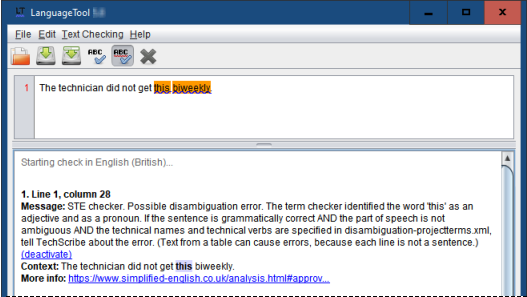
In standard English, the part of speech for a word can have 3 interpretations. In the example that follows, it is possible to parse the word light as a verb, an adjective, or part of a multi-word noun:
Make the tail light. (Verb=come on, adjective=not heavy, noun=tail light.)
The term checker gives part-of-speech warnings for some grammar errors
Although the term checker is not a grammar checker, it finds some grammar errors. For example, in standard English, the word problems is a a plural noun. It has no other part of speech.
This sentence is not correct:
The problems is not easy to correct.
Because the grammar is not correct, the term checker does not identify problems as a plural noun, and thus it gives a warning:
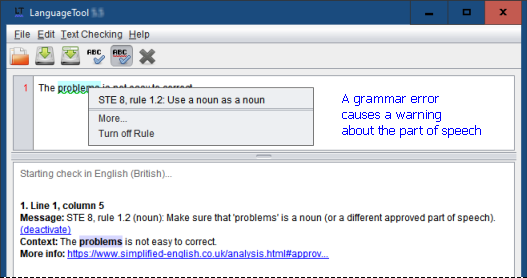
Use approved words only with their approved meanings (rule 1.3)
Each approved word in ASD-STE100 is approved with a specified meaning. For example, the word about means concerned with, not approximately. For other meanings, ASD-STE100 gives the alternatives approximately (adv) and around. The term checker gives a warning that a term is possibly misused for these conditions:
- In the dictionary, a term has the
 symbol in the 'Approved meaning/ALTERNATIVES' column.
symbol in the 'Approved meaning/ALTERNATIVES' column. - A technical noun or a technical verb has a not-approved entry in the dictionary. For example, communicate is approved as a TV (rule 1.12.2.c) and it is also not-approved in the dictionary with the meaning of tell or speak.
- A word is correct in only some contexts. For example, most TVs in rule 1.12.3 are for descriptions only, not procedures. If a verb is also approved in the dictionary (for example fire), the term checker does not give a warning.
- A small number of multi-word terms that writers frequently use incorrectly.
Usually, the term checker cannot tell you if you use a word correctly. It can only find the word and tell you to make sure that it is correct. (The Boeing Simplified English Checker has the same limit. "For example, although it is very difficult to detect approved and unapproved word senses, the Simplified English Checker does this in limited fashion.")
Many approved words in ASD-STE100 have meanings in standard English that are not approved in ASD-STE100. Because ASD-STE100 does not tell you about these meanings, the term checker does not give warnings. The table gives some examples:
| Word | Approved meaning | Correct STE | Incorrect STE |
|---|---|---|---|
| abrasive (adj) | That can remove material by friction | This material is abrasive. | The manager is abrasive. |
| apply (v) | To put or spread something on | Do not apply too much pressure. | These procedures do not apply to the modification. |
| authority (n) | An official organization that gives approval to something | Each authority uses a different procedure. | Your manager has the authority to stop the test. |
| break (v) | To cause to separate or become separated into parts by force | Do not break the glass. | Do not break the rules. |
| capacity (n) | The maximum quantity that something can hold or make | The capacity of the tank is 50 litres. | In your capacity as manager, you must give instructions to the technical writers. |
| concentration (n) | The strength of something contained in a mixture | In a high concentration, this material is poisonous. | Be careful. Your concentration is important to prevent accidents. |
| drain (v) | To remove liquid | Drain the system before you disconnect the components. | Drain the battery before you disconnect the wires. |
| feel (v) | To touch to find | Carefully feel the heater to make sure that it operates. | If you feel that the indication is incorrect, do the test again. |
| give (v) | To provide | This table gives examples of words that are used incorrectly. | If the rope gives, stop the test. |
| hard (adj) | Not easy to cut, not easy to go into or through | Let the adhesive become hard. | This procedure is hard to do. |
| right (adj) | On the east side when you look north | The indicator is on the right panel. | Make sure that you get the right result. |
| start (v) | 1) To begin a procedure, movement, or operation. 2) To come into being, activity, or operation | The engine started because the technician pushed the START button. | The technician started because of the sudden noise. |
| too (adv) | More than is necessary or correct | Make sure that the temperature is not too high. | This computer is defective, too. |
To give warnings to the technical writers in your organization, add rules for the words to grammar-projectterms.xml.
Two or more words that have an incorrect meaning
Two or more approved words that are used together can have an incorrect meaning. The term checker has rules for a small number of multi-word terms that writers frequently use incorrectly. The table gives some examples:
| Word(s) with an incorrect meaning | Approved meaning(s) | Incorrect STE | Alternative |
|---|---|---|---|
| go (verb) | To move to or from something | For more information, go to www.techscribe.co.uk. | refer to |
| on (preposition) | Function word that shows contact, support, direction | For instructions on how to clean the unit, refer to Appendix B. | instructions about |
| point (noun) | A sharp or tapered end, an accurate location | At this point in time, the valve will open. | time |
| where (conjunction) | At, to, or in which location | Where possible, do the inspection in the hangar. | If it is possible |
Refer also to When you use two words together, do not make phrasal verbs (rule 9.3).
Use technical nouns (rule 1.5): proper nouns
"The dictionary does not include technical nouns as approved words, because there are too many, and each manufacturer uses different technical nouns" (ASD-STE100 issue 9). You must add the technical nouns to disambiguation-projectterms.xml.
Some technical nouns are proper nouns:
- Rule 1.5.8. Geographic terms: West, France, Lima.
- Rule 1.5.11. Names of persons, groups, or organizations: European Aviation Safety Agency, Transport Canada Civil Aviation.
- Rule 1.5.15. Names of official documents: Acceptance Test, Structural Repair Manual.
To minimize the initial customization, the term checker shows a warning for these proper nouns:
- A 1-word proper noun that is in LanguageTool: London, Tuesday, September, Jennifer.
- A phrase of 1 or more words that the term checker identifies as a proper noun. A phrase is a proper noun if not all the words are approved and if each word in the phrase has these properties:
- The word starts with an uppercase letter. All the other letters in the word are all lowercase or all uppercase.
- In standard English, the word can be used as a noun or as an adjective (including a past participle adjective).
- The word is not unapproved, unless the phrase is in quote marks.
- Unknown file names, paths, menu sequences, e-mail addresses, URLs, and mathematical equations.
The screenshot shows examples:

Be careful if you deactivate a rule, because possibly, the term checker will not find an incorrect term. For example, if you write 'Federal Aviation Authority', the term checker will not show an error, but the correct term is 'Federal Aviation Administration'.
Use technical nouns: multi-word nouns (rule 1.5 and rule 2.1)
A multi-word noun can be a technical noun. But, not all multi-word nouns are technical nouns.
Rule 1.5.2 gives overhead panel as a possible a technical noun. But, although the term dirty panel is a multi-word noun (adjective + noun), it is not a technical noun. A technical noun is a lexical unit. The words cannot be separated. The table gives some examples:
| Term | technical noun? | Alternative/comment |
|---|---|---|
| adhesive tape | Yes | Not correct English: tape of the adhesive |
| cable tension | No | tension of the cable |
| bottom bolt | ? | the bolt that is at the bottom |
| oil filter | ? | filter for the oil |
The terms bottom bolt and oil filter are possible technical nouns. But, possibly, they are only multi-word nouns. You must decide. If a term refers to an item, then it is usually a technical noun. If the first word in a multi-word noun is an adjective that describes the condition of an item, then the adjective is not part of the technical noun. Thus, in the multi-word noun dirty overhead panel, dirty is an adjective, and overhead panel is a technical noun.
Thousands of permutations of approved nouns are possible technical nouns. The rulegroup STE_RULE_1_5_POSSIBLE_TN helps you to find possible technical nouns. For example, think about the approved nouns source, control, and system. Twenty-seven permutations are possible. The screenshot shows some examples of possible technical nouns.
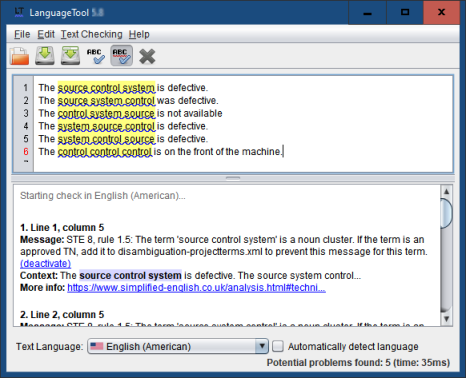
The term checker gives messages only for approved terms that are possible technical nouns. The rule does not give a message for terms that contain unknown words or not-approved words. For example, the word port is not-approved as an adjective and it is approved as a noun (rule 1.5.5). The term port authority is a possible technical noun. But, until you add the technical nouns to disambiguation-projectterms.xml, you will get a message for the not-approved adjective port.
Use STE_RULE_1_5_POSSIBLE_TN at the start of a project. After you find the technical nouns, add the technical nouns to disambiguation-projectterms.xml.
Refer also to ![]()
The disambiguator is different to the LanguageTool disambiguator
Use a word that is not approved in the dictionary only when it is a technical noun or part of a technical noun (rule 1.6)
If a word is not-approved in the dictionary, you can use the word if it is a technical noun that has a different meaning to the not-approved word. ASD-STE100 has examples of not-approved words in the dictionary that are approved as a technical nouns. The technical noun can have the same part of speech as the not-approved word or it can have a different part of speech. The table gives some examples:
| Not-approved word | Incorrect STE | Correct STE | Correct example is in |
|---|---|---|---|
| anchor (v) | The straps are anchored to a full-length rail. | Make sure that the anchor is down. | DOWN (adj) |
| attention (n) | Pay attention to the results. | Attention: this procedure is not easy. | No example, but the technical noun is in rule 1.5.15 |
| base (n) | Make sure that the two spigots at the base of the unit engage. | The base of the triangle is 5 cm. | Rule 1.6 |
| critical (adj) | The condition of the radome is critical to its performance. | At the critical temperature, stop the test. | No example, but the technical noun is in rule 1.5.7 |
| film (n) | Spread a film of compound on the surface of the disc. | For information about thin film deposition, refer to www.osti.gov/servlets/purl/1145751. | Possible technical noun, no example in ASD-STE100 |
| guide (v) | As you lower the pump, guide it on to the mounting bracket. | Let the sleeve move up the guide tube. | UP (prep) |
| idle (v) | Idle the engine for 20 minutes. | Operate the engine at idle for 20 minutes. | idle (v) |
Use American English spelling unless other official directives tell you differently (rule 1.14)
The term checker uses the LanguageTool spelling checker for STE terms. Thus, if you select English (American), and if you write the word colour, you will get a warning about the spelling. If you select English (British), and if you write the word yoctometer, you will get a warning about the spelling.
The term checker does not use the LanguageTool spelling checker for project terms.
For British English, the term checker uses the Oxford spelling
In British English, you can spell some words with s or with z. For example, energise and energize are correct spellings in British English. The z spelling is known as the Oxford spelling. Words that have the Oxford spelling have the language subtag en-GB-oxendict.
As much as possible, the term checker uses the spellings that are approved in ASD-STE100. Thus, the term checker uses the Oxford spelling. You will get an error message if you write energise.
A spelling checker does not find all spelling errors
A spelling checker finds spelling errors. Usually, a spelling checker does not find an error if a word has a correct spelling, but the meaning or the part of speech is not correct. In British English, the sentences that follow are not correct:
1) The manager lost his check book.
2) The license fee is too much.
3) It is necessary to meter the flow of water.
4) The length is approximately 3 meters.
5) Be careful when you practice karate.
6) Use gray paint only.
7) THE PAINT IS GRAY.
8) USE GRAY PAINT IN THIS TEST.
9) The tire pressure is not correct.
10) Slowly inflate the tires.
The Microsoft Word spelling checker finds one error (sentence 6):
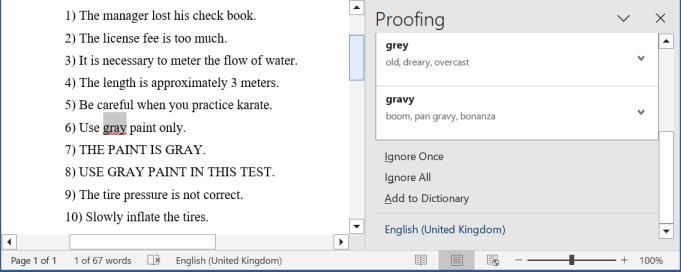
The LanguageTool spelling checker finds one error (sentence 2):
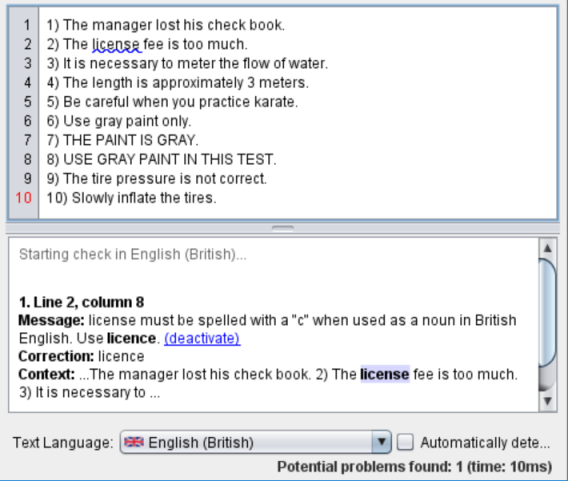
If you use British English, the term checker finds the errors. (The noun check in the multi-word noun check book is correct. The term checker has no semantic information to know that the correct spelling is cheque book.)
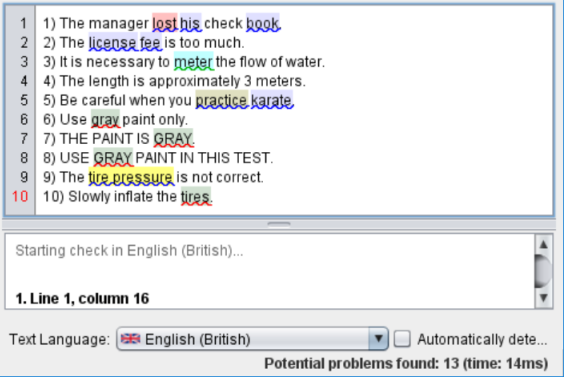
For a very small number of project terms, the correct spelling is dependent on the language variant (the locale).
The verb tire is correct in British English. The noun tire is not correct. You must use tyre. The noun tire is approved in disambiguation-projectterms.xml. (If you do not use British English for the STE checks, you can delete the noun tire.) The term checker rule PROJECT_RULE_1_14_BRE_CONTAINS_AME_SPELLING_NOUNS in \org\languagetool\rules\en\en-GB\grammar.xml gives a warning for the noun tire.
Use the approved forms of a verb to make approved tenses (rule 3.2)
Be + to + infinitive is approved with only some meanings
The structure be + to + infinitive is approved, as shown in these examples from ASD-STE100:
- The function of this special tool is to remove the bushing.
- If your decision is not to replace the unit…
If be + to + infinitive is used as a command or to refer to some types of future action, then it is not correct STE.
| Meaning | Incorrect STE | Correct STE |
|---|---|---|
| command | The indications are to agree with those in Table 2. | The indications must agree with those in Table 2. |
| command | You are not to do the procedure without approval. | You must not do the procedure without approval. |
| future action | Tell the ground crew that you are to operate the system. | Tell the ground crew that you will operate the system. |
| future action | The Accident Report is to include information about the …. | The Accident Report will include information about the …. |
Emphatic do is not an approved tense
Emphatic do has this structure: do + infinitive (www.bbc.co.uk/worldservice/learningenglish/grammar/ask_about_english/071112/). Emphatic do is used to emphasize the primary verb.
Although emphatic do is not a large problem with most technical texts, the term checker has a rule to find emphatic do. Examples of emphatic do:
- Before the accident, the technician did tell the manager that the equipment was defective.
- Before you disassemble the unit, make sure that you do clean the cover.
Sometimes, text can be analysed in 2 different ways. For example, "When you do work on the engine, make sure that…" has 2 grammatical interpretations:
- The text is correct. The word work is a noun.
- The text is incorrect. The word work is a verb.
This ambiguous text is not a problem. The term checker does not find do work.
Use the '-ing' form of a verb only as technical noun or as a modifier in a technical noun (rule 3.5)
A verb cannot be a noun. "the '-ing' form of a verb" means "the '-ing' form of a word".
Rule 3.5 tells you why words that end in ~ing are usually not approved.
Also, there is a problem of semantics. Think about these two sentences:
- The tests for melting glaciers were satisfactory.
- The tests for melting points were satisfactory.
Although the term melting point is a possible technical noun, the term checker parses melting as a verb, because it does not have information about possible technical nouns. (You must add your organization's technical nouns to disambiguation-projectterms.xml.)
Use the passive voice only when the agent is unknown (rule 3.6)
The sentence, "The wires were disconnected by the technician" is in the passive voice. The passive voice is not permitted in a procedure.
ASD-STE100 rule 3.3 gives this example in which the past participle disconnected is an adjective that shows the condition of the wires: "The wires are disconnected."
But, the sentence has 2 grammatical interpretations. Without context, you cannot know if the sentence is active voice or passive voice:
- Possibly, the sentence is in the passive voice. Compare with, "The wires are disconnected. Then the fuse is carefully removed."
- Possibly, disconnected is an adjective that describes the condition of the wires. Compare with, "The wires are dirty."
Persons use their knowledge of the world to disambiguate text:
- Passive voice: The water was drunk.
- Active voice, past participle as an adjective: The waiter was drunk.
A typical spelling checker can disambiguate these texts, because knowledge is put into the rules. For example, the term waiter can be specified as a human agent.
Knowledge of the world is not in the term checker. Thus, the term checker does not disambiguate the passive voice and the past participle as an adjective after the verb BE. The rule for passive voice always gives a warning.
Refer also to ![]()
Passives (www.cs.ox.ac.uk/files/217/passives.pdf)
Use an approved verb to describe an action, not a noun or other part of speech (rule 3.7)
The term checker does not have sufficient 'intelligence' to know when a word is used correctly. For example, think about these sentences:
- Incorrect: Do the adjustment of the controls carefully.
- Correct: Adjust the controls carefully.
- Correct: The temperature adjustment is automatic.
The message in the term checker tells you that possibly, you can use an approved verb as an alternative to the approved noun. That message does not tell you that you must use an approved verb.
When applicable, use an article or demonstrative adjective before a noun (rule 4.5 [= STE 8 rule 2.3])
This rule is necessary for these reasons:
- To make text short, some writers do not use articles.
- In standard English, a noun can be a count noun and a non-count noun. The meanings can be different. Some non-count nouns are used with prepositions to make idioms and adverbial phrases. The tables gives examples:
| Noun | Non-count noun, incorrect STE | Count noun, correct STE |
|---|---|---|
| connection | Incorrect connection will cause damage. | An incorrect connection will cause damage. |
| change | This vending machine does not give change. | Write the change in the logbook. |
| conjunction | Conjunction of the planet with the sun will occur in February 2099. | A conjunction is a word that connects words, phrases, and clauses. |
| cover | Your policy gives cover against damage that is caused by subsidence. | Put the cover on the container. |
| entry | Entry to the building after 17:00 is not permitted. | Make an entry in the log card. |
| gear | Remove unwanted gear from the work area. | Remove the gear from the spindle. |
| method | There is method in his madness. | If the special tool is not available, use an alternative method. |
| port | Port is a type of wine. | The ship is in a port. |
| procedure | Standard procedure is as follows: | The standard procedure is as follows: |
| Noun | Preposition + non-count noun, incorrect STE | Correct STE uses a different word |
|---|---|---|
| accident | The cover broke by accident. | The cover broke accidentally. |
| connection | In connection with the documentation, the technical writers found errors. | The technical writers found errors with the documentation. |
| hand | Try to lift the cover by hand. | Try to lift the cover manually. |
| hand | Make sure that the tool is subsequently on hand for the installation procedure. | Make sure that the tool is subsequently available for the installation procedure. |
| hand | The two procedures go hand in hand. | The two procedures are related. |
| guard | To prevent accidents, always be on guard. | To prevent accidents, always be careful. |
| length | At length, the technician found the cause of the error. | After much time, the technician found the cause of the error. |
| note | The information in Table B is of of note. | The information in Table B is important. |
Do not use a singular determiner before a non-count noun
Rule 4.5 does not give examples of a singular article that is used incorrectly with a non-count noun. But, rule 4.5 is applicable. The table gives examples:
| Noun | Count noun, incorrect STE | Non-count noun, correct STE |
|---|---|---|
| air | The cat had an air of supreme indifference. | Cold air comes out of the outlets. |
| condensation | A large condensation of the document is necessary. | The cold temperature caused condensation on the window. |
| gravity | The oil has an unusually low API gravity. | Gravity is the force that causes something to fall to the ground. |
| iron | A hot iron can burn you. | Steel is made from iron. |
| performance | We want a good performance from you. | Fuel leaks can decrease engine performance. |
| tin | Did the technician use a screwdriver to open a tin of paint? | Tin is a soft shiny metal. |
| wood | A wood is a small forest. | Wood is a good insulation material. |
For your project, if a non-count noun in the term checker is a technical noun or part a technical noun, add the technical noun to disambiguation-projectterms.xml.
An article is a type of determiner. These other determiners are not used with non-count nouns: another, each, either, every, neither, one. Refer to Determiners and types of noun (https://dictionary.cambridge.org/grammar/british-grammar/determiners-and-types-of-noun). Although some of these determiners are not approved terms, the rule finds errors if a noun-count noun is used with these determiners.
Conjoined noun phrases can be ambiguous
A conjoined noun phrase is two smaller noun phrases that are joined by and or or. Some conjoined noun phrases are ambiguous. Think about the sentence that follows:
The area is a wet sand and gravel strip adjacent to the building.
Two interpretations are possible:
- The area is (a wet sand) and (a gravel strip) adjacent to the building.
- The area is a wet (sand and gravel strip) adjacent to the building.
The rules in the term checker use the chunker. For the example sentence, the chunker identifies a and gravel as the start of noun phrases. This is equivalent to the first interpretation. Thus, the term checker give two warnings for rule 4.5. The warning for sand is because sand is approved as a non-count noun. The warning for strip is because strip is approved as a count noun:
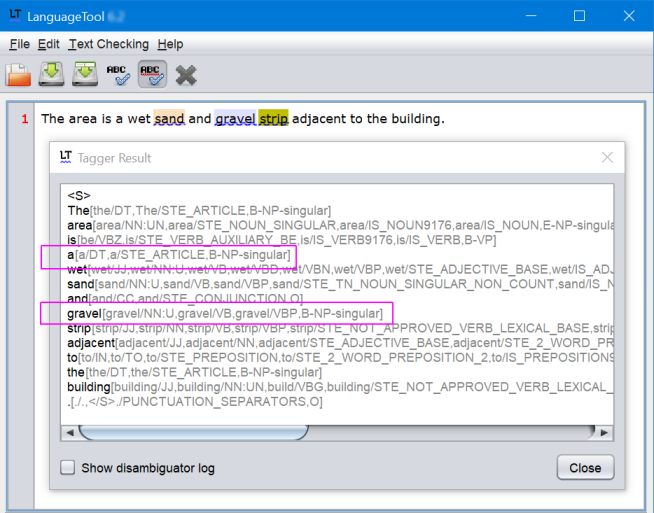
Use a maximum of 20 words in each sentence (rule 5.1)
For procedures, the maximum length of a sentence is 20 words (rule 5.1).
For descriptions, the maximum length of a sentence is 25 words (rule 6.3).
For the rules for word counts, refer to ASD-STE100 section 8.
The rule in the term checker counts alphanumeric tokens. The rule gives a message for the twenty-first alphanumeric token in a sentence. Possibly, the sentence conforms to the STE rules. Incorrect warnings have these causes:
- One word contains more than one token. Examples: 10,003.59 (3 tokens), U+FFFF (3 tokens), 10 °C (2 tokens), manufacturer's ('s as possessive, 2 tokens).
- Two or more words are in parentheses (ASD-STE100, rule 8.5).
- Two or more words are quoted text (ASD-STE100, rule 8.6). Example: "FRAGILE - Handle with care" (7 tokens).
- A descriptive sentence contains between 21 and 25 words (ASD-STE100, rule 6.3).
- A colon is used to start a vertical list (ASD-STE100, rule 8.4) and there is no paragraph break between the colon and the first list item. LanguageTool does not identify the colon as the end of a sentence.
Use all standard English punctuation marks, but not the semicolon (;) (rule 8.1)
Rule 8.1 tells you that you must not use semicolons. Thus, the term checker gives a warning for a semicolon that is used as a punctuation mark. The term checker does not give a warning for a semicolon if it is in an HTML character entity reference.
In an index, a semicolon is used as a separator in 'see also' cross-references. Refer to ISO 999:1996, section 7.5.2.1 (https://www.iso.org/standard/5446.html). Although rule 8.1 is about instructions and descriptions, the term checker gives a warning for a semicolon that is in an index.
Although it is possible to make a project rule to prevent a warning for a semicolon that is in an index, TechScribe recommends that you do not make a rule, because your text will not conform to ASD-STE100. Refer to 'PROJECT IGNORE A SEMICOLON IN AN INDEX' in disambiguation-projectterms.xml.
Use hyphens (-) to connect words that are directly related (rule 8.2)
Rule 8.2 tells you how to use hyphens to connect words or parts of words.
The term checker ignores these hyphenated terms:
- Three-word adjectives that have the structure number-to-number, for example, three-to-one and four-to-three (part of rule 8.2.1).
- Two-word fractions and numbers, for example, forty-seven, ninety-ninth, and three-sixteenths (rule 8.2.2).
- Units of measurement that are adjectives before a noun, if the first part of the adjective is a cardinal number. Examples:
- Use a 5-liter container.
- Use a five-liter container.
PROJECT_RULE_1_11_HYPHENATED_ADJECTIVEStells you to use 5-liter. If you want to use five-liter, changePROJECT_RULE_1_11_HYPHENATED_ADJECTIVES.
Rule 8.2 tells you that "a hyphen is different from a dash, which keeps words apart, indicates a range, or shows a pause". The term checker rule finds a hyphen that is possibly incorrectly used as a word separator if a word has no POS tag. If the hyphenated term is correct, add the hyphenated terms to disambiguation-projectterms.xml. (Rule 1.1 finds all unknown terms, thus, for many hyphenated terms, you will get 2 warnings.)
When you use two words together, do not make phrasal verbs (rule 9.3)
The term checker finds some phrasal verbs if the parts of the phrasal verb are together. For example, the term checker finds the two phrasal verbs that are examples in rule 9.3 (put out and give off).
The term checker does not find a phrasal verb if a noun or a noun phrase is between the parts of the phrasal verb.
A rule for a phrasal verb can cause an incorrect warning. Usually, a person uses knowledge of the world to know if a term is a phrasal verb. The term checker does not have this knowledge. The examples in the table show that go through can be a phrasal verb and it can be a verb that is followed by a preposition.
| Example | Comment |
|---|---|
| The water must go through the filter. | Correct STE (verb + preposition) |
| The technical writer must go through the document. | Incorrect STE (phrasal verb) |
| If the scratch goes through the protective layer, discard the unit. | Correct STE (verb + preposition) |
| The technician went through the tunnel. | Correct STE (verb + preposition) |
| The material goes through this process: | Incorrect STE (phrasal verb) |
The term checker cannot tell you if you use a term correctly. It can only find the term and tell you to make sure that it is correct.
The pronoun "this" (GR-4)
GR-4 tells you to make sure that the reader knows what the pronoun this refers to. The example is "Make sure that the cover is not locked (this can cause damage to the probe.)"
GR-3 tells you that a pronoun refers back to a person, a place, or a thing. But, a pronoun can also refer forward. This forward reference makes a sentence more difficult than necessary. For example, think about these two sentences:
- If you think that this is not a correct sequence, tell your manager.
- If you think that this sequence is not correct, tell your manager.
For the first sentence, the term checker gives a warning for the pronoun this, which is a forward reference to the noun sequence.

Dictionary, forms of approved words, page 2-0-5
The dictionary shows only the singular form of each approved noun. The plural form of a count noun is permitted unless the dictionary tells you that it is not approved. The dictionary does not tell you if a noun is a count noun or a non-count noun.
In standard English, a noun can be a count noun with one meaning and a non-count noun with a different meaning. A good example is the noun damage. The noun is approved in the dictionary. It has the meaning, "The result of an occurrence that causes deterioration of the condition of something". For this meaning, the noun is a non-count noun.
The plural noun damages has the meaning, "compensation in money imposed by law for loss or injury" (www.merriam-webster.com/dictionary/damage).
The dictionary does not tell you that the plural noun damages is not an approved noun. The term checker has a rule that finds damages and a small number of other plural nouns. The rule tells you to use the singular form of the noun. If the plural noun is approved for your documentation, add it to disambiguation-projectterms.xml.
Some technical nouns are not specified
Some approved examples in the dictionary contain words that are used as technical nouns, but which are not specified as technical nouns. Some of these words are not-approved in the dictionary. The term checker gives a warning for these words. Some examples are as follows:
- When you install the antenna, the alignment arrow must point forward.
- The reset device operates in the opposite direction.
- Adjust the stop bolt in increments of 5 mm.

If a term is approved, to prevent a warning, add the term to disambiguation-projectterms.xml.
Subject-verb agreement in prepositional phrases
A subject must agree with its related verb. In a simple sentence, errors are easy to find.
Subject-verb agreement in plural prepositional phrases
If a plural prepositional phrase is between a singular subject and the verb, errors are not always easy to find. Also, in standard English, specially British English, collective nouns can have a singular verb or a plural verb. Refer to 'Collective Nouns and Verb Agreement' ( https://www.britannica.com/dictionary/eb/qa/Collective-Nouns-and-Verb-Agreement.
A rule finds errors of subject-verb agreement if a singular subject is before a plural prepositional phrase. The rule also finds some errors for adverb phrases that do not have a comma after the adverb phrase (in the examples, At the time of the explosion and In the course of the 19th century):
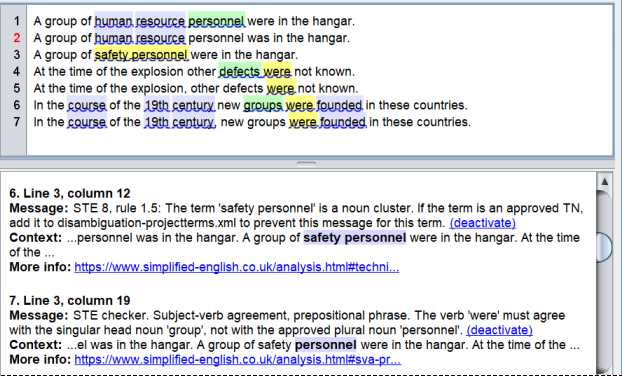
For the example, "A group of safety personnel were in the hangar.", you cannot see a green background on the word personnel because the rule for multi-word nouns (rule 1.5 and rule 2.1) is selected and it gives a yellow background to the term safety personnel. A message for the subject-verb agreement is in the lower part of the screen, but to see the green background, you must deactivate the rule for multi-word nouns.
Subject-verb agreement in singular prepositional phrases
A rule finds errors of subject-verb agreement if a plural subject is before a singular prepositional phrase:
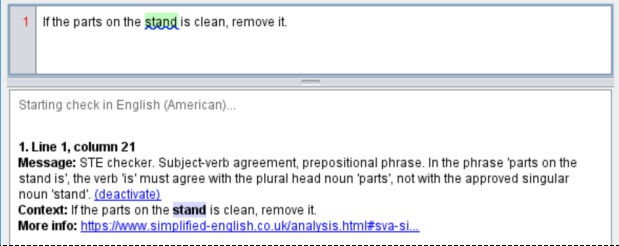
The term checker cannot give an analysis of more than one sentence
The term checker uses LanguageTool. An XML grammar rule in LanguageTool can give an analysis of only one sentence. A rule cannot give an analysis of two or more sentences. Some errors are dependent on context, and the term checker does not always find these errors. Think about these examples:
- Correct example:
The software automatically gives an analysis of the document parts that follow.
1) Codes.
2) Tests.
3) Records. - Incorrect example:
The unit automatically does the actions that follow.
1) Codes.
2) Tests.
3) Records.
The first example is correct because the words in the list are nouns. The second example is incorrect because the words in the list are verbs. (Also, the noun actions is not approved.) The term checker cannot use the first sentence of each example to give a correct analysis of items in a list.